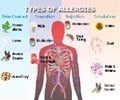Discover how climate change is intensifying spring allergies with people experiencing symptoms like sneezing and sniffles.
- Spring allergies are intensifying due to climate change, leading to increased sneezing and sniffling
- Pollen and air pollution are the main culprits triggering allergies during spring
- Preventive measures like reducing exposure to allergens and seeking medical treatment can help alleviate allergy symptoms
Understanding Spring Allergies: Causes and Symptoms
Spring allergies are caused by pollen, which is released into the air by plants during the spring season. Trees, grasses, and flowers all release pollen into the air, which can trigger an allergic reaction in some people. The symptoms of spring allergies include sneezing, sniffling, coughing, watery eyes, and a runny nose.Climate Change and Allergy Intensity
Climate change is intensifying spring allergies by causing changes in the timing and distribution of pollen. The warmer temperatures and longer growing seasons have caused plants to produce more pollen, and earlier than usual. The changing weather patterns also lead to unpredictable fluctuations in pollen levels, which can worsen allergy symptoms. The increasing carbon dioxide levels in the atmosphere have also been found to increase the amount of pollen that plants produce. Studies have shown that the rising levels of carbon dioxide in the atmosphere can cause an increase in the amount of pollen that plants produce, which can exacerbate spring allergies.Tips to Coping with Spring Allergies
The good news is that there are steps that people can take to reduce the impact of spring allergies. Here are a few tips:Monitor pollen levels:
Keep track of the pollen levels in your area by checking your local weather forecast or online pollen trackers. This can help you plan your outdoor activities around the times when the pollen counts are low.Keep windows closed:
Keep your windows closed to prevent pollen from entering your home. If you need to cool your home, use air conditioning instead of opening windows.Change your clothes:
After spending time outdoors, change your clothes and take a shower to remove any pollen that may have been collected on your skin and clothes.Use air purifiers:
Use air purifiers in your home to filter out pollen and other allergens from the air.Take allergy medication:
If your symptoms are severe, consider taking over-the-counter allergy medications or speaking to your doctor about prescription options.
Additionally, it's important to recognize the impact of climate change on our environment and take steps to reduce our carbon footprint. Climate change is not only impacting our health but also our planet and its resources. We can all make a difference by making small changes in our daily lives, such as reducing our energy consumption, eating a plant-based diet, and using public transportation or carpooling.
In conclusion, spring allergies are intensifying with climate change, but there are steps that people can take to reduce their impact. By monitoring pollen levels, keeping windows closed, changing clothes after spending time outdoors, using air purifiers, and taking allergy medication, people can reduce the severity of their symptoms. It's also crucial to recognize the impact of climate change on our environment and take steps to reduce our carbon footprint. Let's work together to protect our health and the planet we call home.
Source-Medindia














